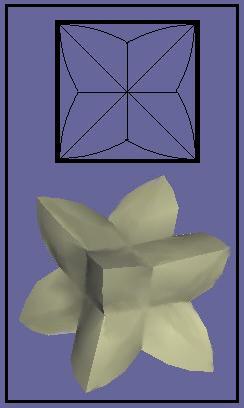I pictured the object as a cube with 12 cusp shaped grooves cut out of it. A cube can be divided into six congruent square pyramids with the apexes at the center of the cube. By making two cusp grooves in the square face, each pyramid will be one sixth of the object in question.
Any cross section of the cut pyramid made parallel to the square base will look either one square where the cuts did not reach, or four disconnected squares where the cuts did reach. The deepest point the cuts can reach is 1 - sqrt[3]/2 units in from the base, assuming the bases edges are 1 unit. If the cross section is at a height x from the base, then the cuts at that point are 1-2*sqrt[2x-x^2] and the cross section will have a total width of 1-2x.
The total area removed from such a cross section equals
2*(1-2x)*(1-2*sqrt[2x-x^2]) - (1-2*sqrt[2x-x^2])^2
Integrating this expression from x = 0 to x = 1 - sqrt[3]/2 will give the total volume removed from each pyramid. Six times this value will be the total amount removed from the cube.
After simplifying the expression, the integral is:
Integ{1-sqrt[3]/2, 0} {1 - 12x + 4x^2 + 8x*sqrt[2x-x^2]} dx
This integral can be calculated by splitting it into three smaller integrals:
Integ{1-sqrt[3]/2, 0} {1 - 12x + 4x^2} dx
Integ{1-sqrt[3]/2, 0} {(8x-8)*sqrt[2x-x^2]} dx
Integ{1-sqrt[3]/2, 0} {8*sqrt[2x-x^2]} dx
The first integral evaluates to (18*sqrt[3] - 31)/6
Using the substitution y=2x-x^2, the second integral evaluates to -1/3
Using the substitution sin[t] = x-1, the third integral evaluates to 2*pi/3 - sqrt[3]
The sum of the small integrals makes the large integral equal to
(-33 + 12*sqrt[3] + 4*pi)/6
and the total volume removed from the cube equal to
-33 + 12*sqrt[3] + 4*pi = .350980305186
This agrees with Charlie's numerical integration of 35.1%




